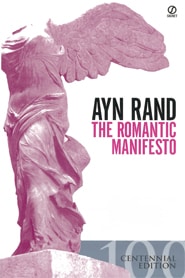

Ayn Rand, born in St. Petersburg in 1905, recalls growing up in “the last afterglow of the most radiant cultural atmosphere in human history (achieved not by Russian, but by Western culture).” It was an era of literary giants such as Victor Hugo, Friedrich Schiller and Edmond Rostand, when “art projected an overwhelming sense of intellectual freedom, of depth, i.e., concern with fundamental problems, of demanding standards, of inexhaustible originality, of unlimited possibilities, and, above all, of profound respect for man.”
That atmosphere’s evaporation in the twentieth century — not only from neglect but through nihilistic movements in all of art’s branches — helped inspire Rand to elucidate her own esthetic theory and campaign for an esthetic renaissance. In these essays, she argues that art is not a luxury but a critical need — not a material need, but a need of man’s rational mind, on which his material survival depends.
— Ayn Rand, “Introduction,” The Romantic Manifesto
In this collection, Ayn Rand explains the indispensable function of art in man’s life (chapter 1), the source of man’s deeply personal, emotional response to art (chapter 2), and how an artist’s fundamental, often unstated view of man and of the world shapes his creations (chapter 3). In a chapter that includes an extended discussion of music, Rand explores the valid forms of art (chapter 4).
Rand also presents her distinctive theory of literature (chapter 5) and sheds new light on Romanticism, under which category Rand classified her own work (chapters 6 and 10). Later essays explain how contemporary art reveals the debased intellectual and esthetic state of our culture (chapters 7, 8 and 9).
In the final essay (chapter 11), Rand articulates the goal of her own fiction writing and upholds the value of art that depicts men “as they might be and ought to be.” Chapter 12 is a short story Rand wrote in 1940, illustrating how an artist’s “sense of life” directs his subconscious and shapes his creative imagination.
“Prior to the nineteenth century, literature presented man as a helpless being whose life and actions were determined by forces beyond his control: either by fate and the gods, as in the Greek tragedies, or by an innate weakness, ‘a tragic flaw,’ as in the plays of Shakespeare. Writers regarded man as metaphysically impotent; their basic premise was determinism. On that premise, one could not project what might happen to men; one could only record what did happen — and chronicles were the appropriate literary form of such recording.
“Man as a being who possesses the faculty of volition did not appear in literature until the nineteenth century. The novel was his proper literary form — and Romanticism was the great new movement in art. Romanticism saw man as a being able to choose his values, to achieve his goals, to control his own existence. The Romantic writers did not record the events that had happened, but projected the events that should happen; they did not record the choices men had made, but projected the choices men ought to make.”
Philosophy, Ayn Rand held, is a practical guide to action — but a worldview that’s held solely in the form of complex conceptual relationships cannot be fully understood or applied. Works of art serve a unique condensing function for the human mind, “making real” our most abstract concepts of man and life through stylized recreations of reality. As Rand puts it, “Art is a concretization of metaphysics. Art brings man’s concepts to the perceptual level of his consciousness and allows him to grasp them directly, as if they were percepts.”
For example, “consider two statues of man: one as a Greek god, the other as a deformed medieval monstrosity. Both are metaphysical estimates of man; both are projections of the artist’s view of man’s nature; both are concretized representations of the philosophy of their respective cultures.”
According to Ayn Rand, every individual has a basic attitude toward life — what she calls a “sense of life” — consisting in essence of subconscious, emotional value judgments about what’s important in life — values which, if verbalized, would resemble these examples offered by Rand: “It is important to understand things” — “It is important to obey my parents” — “It is important to act on my own” — “It is important to please other people” — “It is important to fight for what I want” — “It is important not to make enemies” — “My life is important” — “Who am I to stick my neck out?”
Rand contends that the existence of a sense of life is doubly crucial to understanding art: (1) it subconsciously guides an artist’s decisions about what to include and what to omit in a work of literature, painting, sculpture, etc.; and (2) it shapes one’s emotional response to a given work of art.
Ayn Rand regards Romanticism as “the greatest achievement in art history,” a category of art premised on the implicit but fundamental idea that man possesses free will. Naturalism, by contrast, views man as determined by forces outside of his control.
In this book, Rand discusses literary exemplars of both categories — including Hugo, Dostoevsky, and Rostand as Romanticists and Balzac and Tolstoy as Naturalists — probing their literary methods, assessing the value of their works and explaining Romanticism’s downfall. Rand also decries what she calls “bootleg romanticism,” exemplified by “tongue-in-cheek” thrillers that mock the quest for values while smuggling in Romantic elements to cash in on their appeal.
Rand intended this book as a literal manifesto that could ignite a renaissance of Romantic art. “If there is to be [a Romantic movement] in art of the future,” she wrote, “this book will have helped it to come into being.”
Ayn Rand presents her esthetic theory with illustrations from works through the ages, both great and pedestrian, drawing examples from every major form of art.
Here is a chance to see a great artist comment on works of literature (by Hugo, Tolstoy, Schiller, Dumas, Rostand, Scott, Rolland, Hawthorne, Sienkiewicz, Lewis, Dreiser, Wolfe, O’Neill, Chayefsky) — and popular fiction (by Edgar Allan Poe, H. G. Wells, Jules Verne, Edna Ferber, John O’Hara, Ian Fleming, Mickey Spillane, Ira Levin) — and painting (by Vermeer, Dali, Goya) — and dance (ballet, tap, modern) — and music (symphonic, popular, opera, operetta).
Rand also includes examples from television (Rod Serling’s The Twilight Zone, The Avengers), motion pictures (Fritz Lang’s Siegfried, Alfred Hitchcock, the James Bond films), and performance (Sean Connery, Fred Astaire).
As a champion of Romantic art, Ayn Rand regarded much of so-called modern art as a nihilistic attack on art’s crucial role in the life of a conceptual being. “To reduce man’s consciousness to the level of sensations, with no capacity to integrate them, is the intention behind the reducing of language to grunts, of literature to ‘moods,’ of painting to smears, of sculpture to slabs, of music to noise,” Rand writes.
In many of the book’s essays, Rand explains the philosophical source of art’s widespread disintegration in the twentieth century and argues that modern “art” is not a category of art. “‘Something in a frame hung on a wall’ is not a definition of painting,” she observes wryly.
To properly define art, one must understand the nature of a work of art and its function in man’s life, which is what Rand sets out to do in developing her new theory of esthetics.